Roles of Epidemiology in the Health Care Industry
VerifiedAdded on 2023/01/06
|13
|4357
|54
AI Summary
This article discusses the roles of epidemiology in the health care industry, specifically focusing on how the principles of epidemiology assist various roles such as nurses, doctors, and general practitioners. It explores the concepts of distribution, determinants, and application of epidemiology in gathering data, analyzing statistics, and making informed decisions in the field of healthcare.
Contribute Materials
Your contribution can guide someone’s learning journey. Share your
documents today.
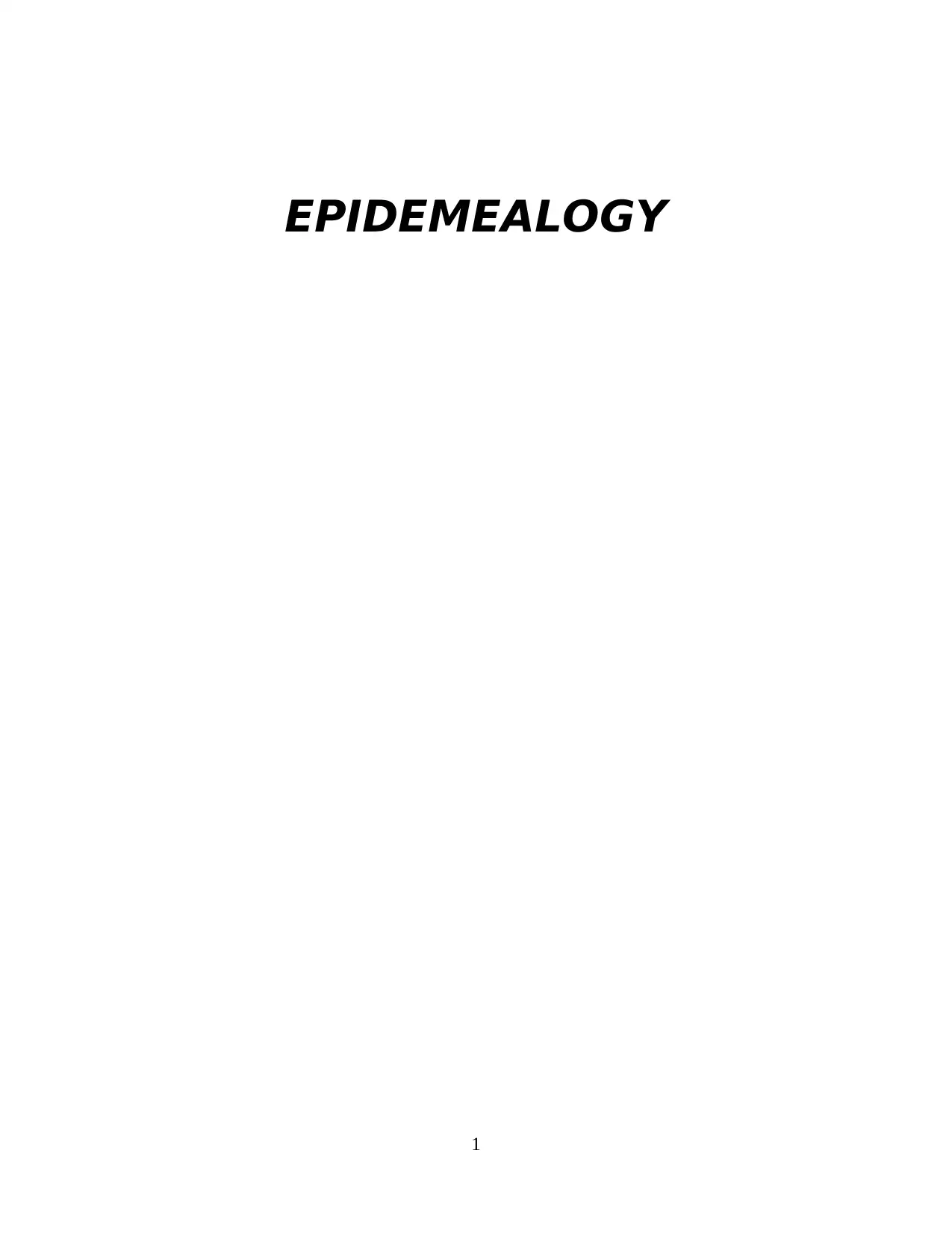
EPIDEMEALOGY
1
1
Secure Best Marks with AI Grader
Need help grading? Try our AI Grader for instant feedback on your assignments.

Table of Contents
REFERENCES................................................................................................................................8
2
REFERENCES................................................................................................................................8
2
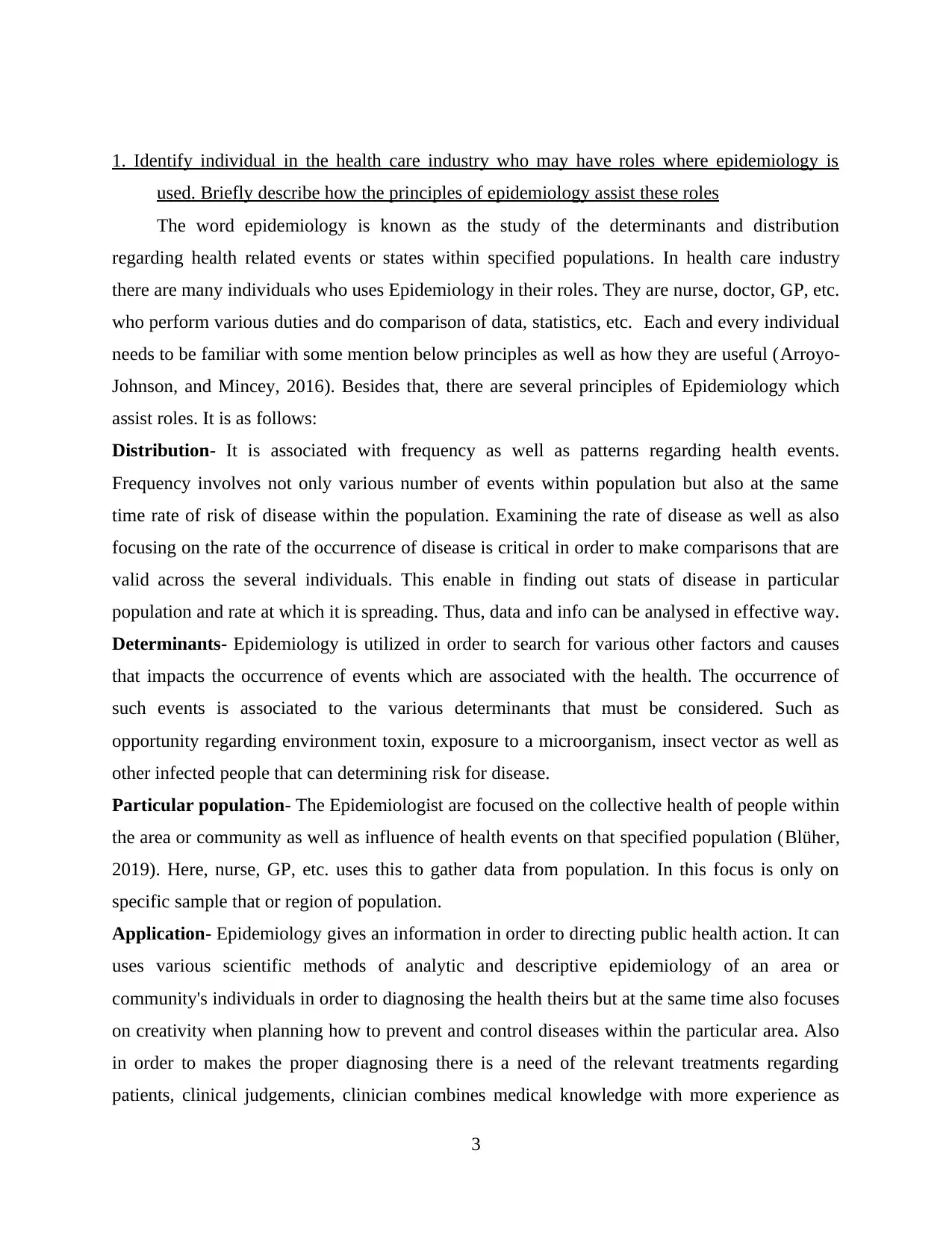
1. Identify individual in the health care industry who may have roles where epidemiology is
used. Briefly describe how the principles of epidemiology assist these roles
The word epidemiology is known as the study of the determinants and distribution
regarding health related events or states within specified populations. In health care industry
there are many individuals who uses Epidemiology in their roles. They are nurse, doctor, GP, etc.
who perform various duties and do comparison of data, statistics, etc. Each and every individual
needs to be familiar with some mention below principles as well as how they are useful (Arroyo-
Johnson, and Mincey, 2016). Besides that, there are several principles of Epidemiology which
assist roles. It is as follows:
Distribution- It is associated with frequency as well as patterns regarding health events.
Frequency involves not only various number of events within population but also at the same
time rate of risk of disease within the population. Examining the rate of disease as well as also
focusing on the rate of the occurrence of disease is critical in order to make comparisons that are
valid across the several individuals. This enable in finding out stats of disease in particular
population and rate at which it is spreading. Thus, data and info can be analysed in effective way.
Determinants- Epidemiology is utilized in order to search for various other factors and causes
that impacts the occurrence of events which are associated with the health. The occurrence of
such events is associated to the various determinants that must be considered. Such as
opportunity regarding environment toxin, exposure to a microorganism, insect vector as well as
other infected people that can determining risk for disease.
Particular population- The Epidemiologist are focused on the collective health of people within
the area or community as well as influence of health events on that specified population (Blüher,
2019). Here, nurse, GP, etc. uses this to gather data from population. In this focus is only on
specific sample that or region of population.
Application- Epidemiology gives an information in order to directing public health action. It can
uses various scientific methods of analytic and descriptive epidemiology of an area or
community's individuals in order to diagnosing the health theirs but at the same time also focuses
on creativity when planning how to prevent and control diseases within the particular area. Also
in order to makes the proper diagnosing there is a need of the relevant treatments regarding
patients, clinical judgements, clinician combines medical knowledge with more experience as
3
used. Briefly describe how the principles of epidemiology assist these roles
The word epidemiology is known as the study of the determinants and distribution
regarding health related events or states within specified populations. In health care industry
there are many individuals who uses Epidemiology in their roles. They are nurse, doctor, GP, etc.
who perform various duties and do comparison of data, statistics, etc. Each and every individual
needs to be familiar with some mention below principles as well as how they are useful (Arroyo-
Johnson, and Mincey, 2016). Besides that, there are several principles of Epidemiology which
assist roles. It is as follows:
Distribution- It is associated with frequency as well as patterns regarding health events.
Frequency involves not only various number of events within population but also at the same
time rate of risk of disease within the population. Examining the rate of disease as well as also
focusing on the rate of the occurrence of disease is critical in order to make comparisons that are
valid across the several individuals. This enable in finding out stats of disease in particular
population and rate at which it is spreading. Thus, data and info can be analysed in effective way.
Determinants- Epidemiology is utilized in order to search for various other factors and causes
that impacts the occurrence of events which are associated with the health. The occurrence of
such events is associated to the various determinants that must be considered. Such as
opportunity regarding environment toxin, exposure to a microorganism, insect vector as well as
other infected people that can determining risk for disease.
Particular population- The Epidemiologist are focused on the collective health of people within
the area or community as well as influence of health events on that specified population (Blüher,
2019). Here, nurse, GP, etc. uses this to gather data from population. In this focus is only on
specific sample that or region of population.
Application- Epidemiology gives an information in order to directing public health action. It can
uses various scientific methods of analytic and descriptive epidemiology of an area or
community's individuals in order to diagnosing the health theirs but at the same time also focuses
on creativity when planning how to prevent and control diseases within the particular area. Also
in order to makes the proper diagnosing there is a need of the relevant treatments regarding
patients, clinical judgements, clinician combines medical knowledge with more experience as
3
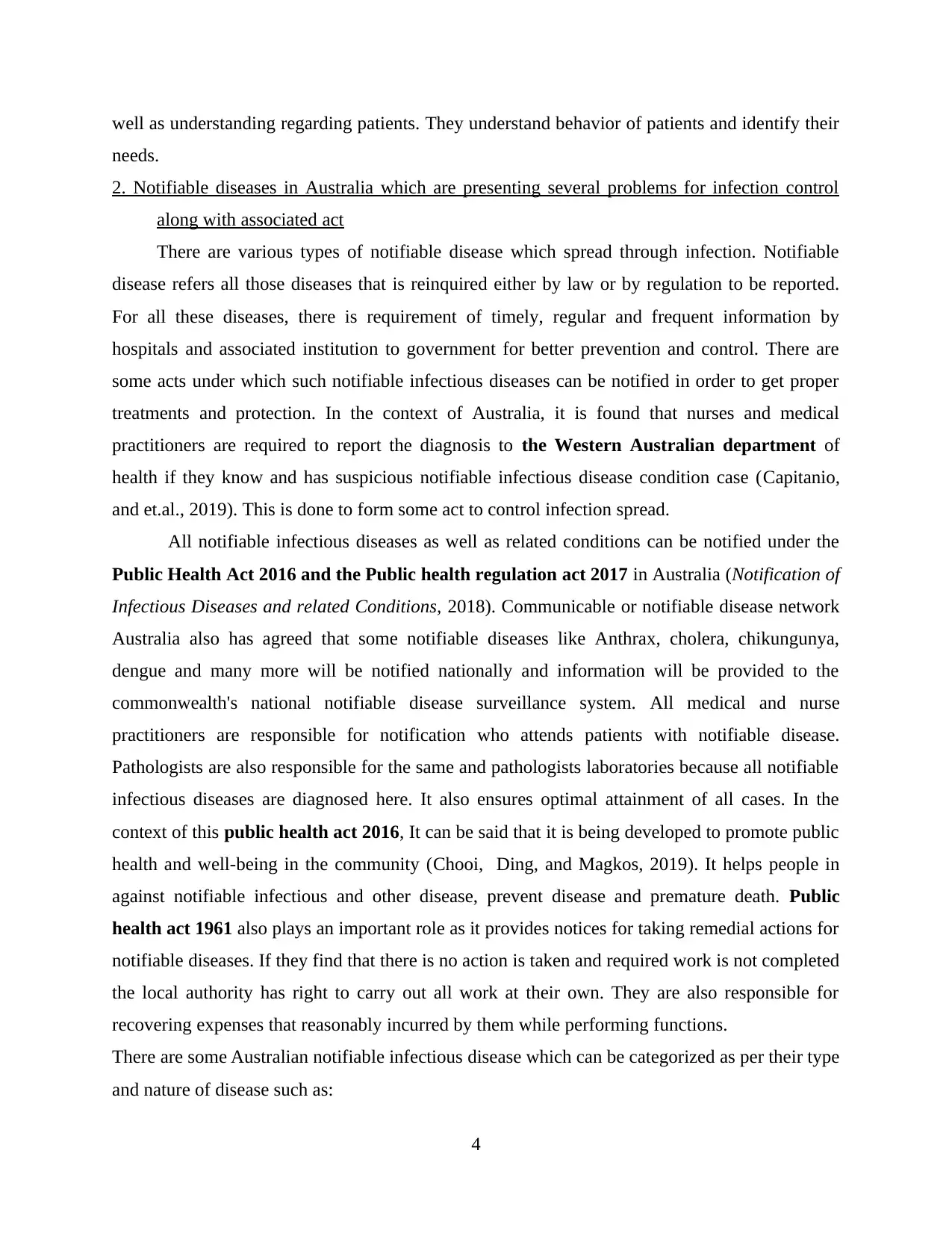
well as understanding regarding patients. They understand behavior of patients and identify their
needs.
2. Notifiable diseases in Australia which are presenting several problems for infection control
along with associated act
There are various types of notifiable disease which spread through infection. Notifiable
disease refers all those diseases that is reinquired either by law or by regulation to be reported.
For all these diseases, there is requirement of timely, regular and frequent information by
hospitals and associated institution to government for better prevention and control. There are
some acts under which such notifiable infectious diseases can be notified in order to get proper
treatments and protection. In the context of Australia, it is found that nurses and medical
practitioners are required to report the diagnosis to the Western Australian department of
health if they know and has suspicious notifiable infectious disease condition case (Capitanio,
and et.al., 2019). This is done to form some act to control infection spread.
All notifiable infectious diseases as well as related conditions can be notified under the
Public Health Act 2016 and the Public health regulation act 2017 in Australia (Notification of
Infectious Diseases and related Conditions, 2018). Communicable or notifiable disease network
Australia also has agreed that some notifiable diseases like Anthrax, cholera, chikungunya,
dengue and many more will be notified nationally and information will be provided to the
commonwealth's national notifiable disease surveillance system. All medical and nurse
practitioners are responsible for notification who attends patients with notifiable disease.
Pathologists are also responsible for the same and pathologists laboratories because all notifiable
infectious diseases are diagnosed here. It also ensures optimal attainment of all cases. In the
context of this public health act 2016, It can be said that it is being developed to promote public
health and well-being in the community (Chooi, Ding, and Magkos, 2019). It helps people in
against notifiable infectious and other disease, prevent disease and premature death. Public
health act 1961 also plays an important role as it provides notices for taking remedial actions for
notifiable diseases. If they find that there is no action is taken and required work is not completed
the local authority has right to carry out all work at their own. They are also responsible for
recovering expenses that reasonably incurred by them while performing functions.
There are some Australian notifiable infectious disease which can be categorized as per their type
and nature of disease such as:
4
needs.
2. Notifiable diseases in Australia which are presenting several problems for infection control
along with associated act
There are various types of notifiable disease which spread through infection. Notifiable
disease refers all those diseases that is reinquired either by law or by regulation to be reported.
For all these diseases, there is requirement of timely, regular and frequent information by
hospitals and associated institution to government for better prevention and control. There are
some acts under which such notifiable infectious diseases can be notified in order to get proper
treatments and protection. In the context of Australia, it is found that nurses and medical
practitioners are required to report the diagnosis to the Western Australian department of
health if they know and has suspicious notifiable infectious disease condition case (Capitanio,
and et.al., 2019). This is done to form some act to control infection spread.
All notifiable infectious diseases as well as related conditions can be notified under the
Public Health Act 2016 and the Public health regulation act 2017 in Australia (Notification of
Infectious Diseases and related Conditions, 2018). Communicable or notifiable disease network
Australia also has agreed that some notifiable diseases like Anthrax, cholera, chikungunya,
dengue and many more will be notified nationally and information will be provided to the
commonwealth's national notifiable disease surveillance system. All medical and nurse
practitioners are responsible for notification who attends patients with notifiable disease.
Pathologists are also responsible for the same and pathologists laboratories because all notifiable
infectious diseases are diagnosed here. It also ensures optimal attainment of all cases. In the
context of this public health act 2016, It can be said that it is being developed to promote public
health and well-being in the community (Chooi, Ding, and Magkos, 2019). It helps people in
against notifiable infectious and other disease, prevent disease and premature death. Public
health act 1961 also plays an important role as it provides notices for taking remedial actions for
notifiable diseases. If they find that there is no action is taken and required work is not completed
the local authority has right to carry out all work at their own. They are also responsible for
recovering expenses that reasonably incurred by them while performing functions.
There are some Australian notifiable infectious disease which can be categorized as per their type
and nature of disease such as:
4
Secure Best Marks with AI Grader
Need help grading? Try our AI Grader for instant feedback on your assignments.
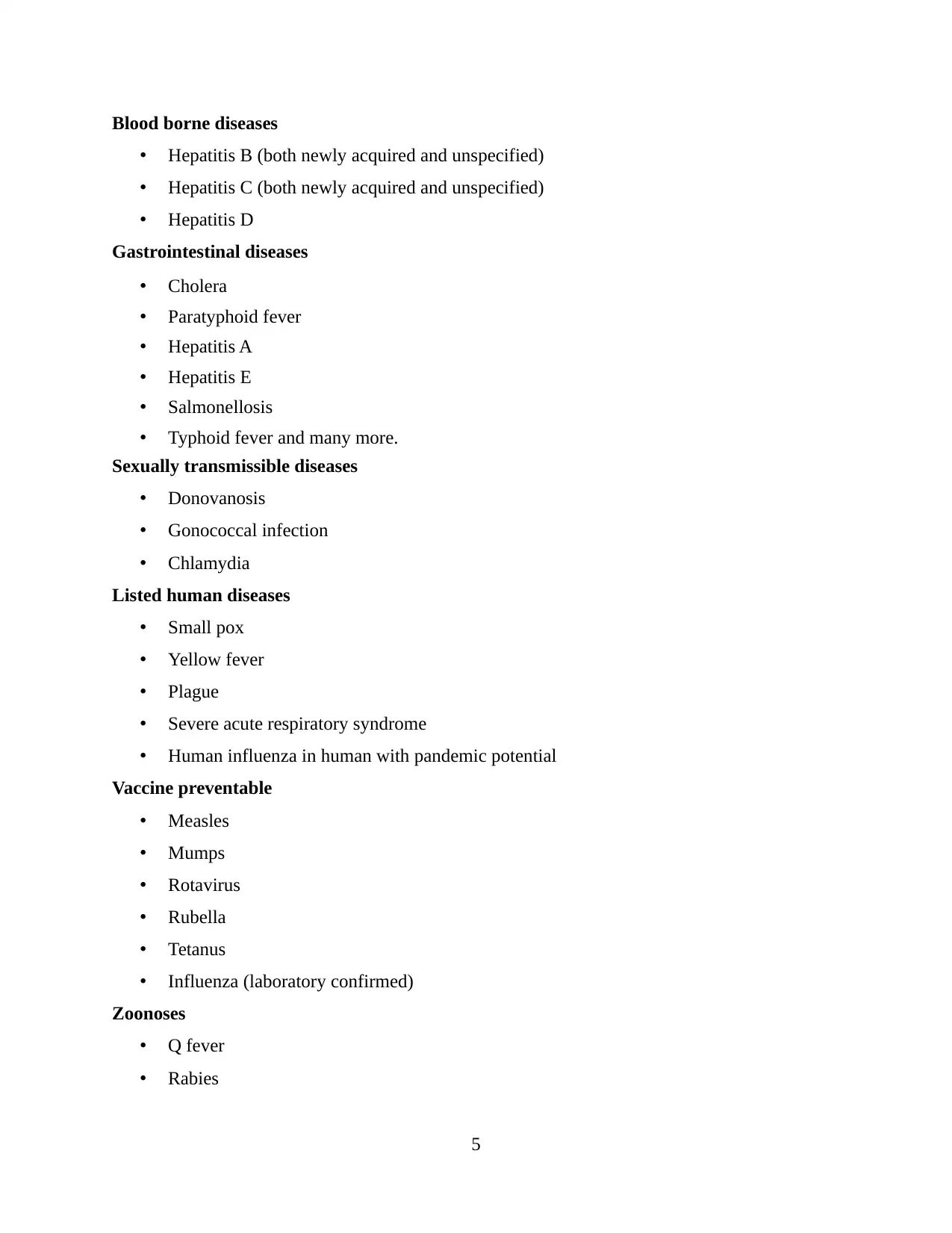
Blood borne diseases
• Hepatitis B (both newly acquired and unspecified)
• Hepatitis C (both newly acquired and unspecified)
• Hepatitis D
Gastrointestinal diseases
• Cholera
• Paratyphoid fever
• Hepatitis A
• Hepatitis E
• Salmonellosis
• Typhoid fever and many more.
Sexually transmissible diseases
• Donovanosis
• Gonococcal infection
• Chlamydia
Listed human diseases
• Small pox
• Yellow fever
• Plague
• Severe acute respiratory syndrome
• Human influenza in human with pandemic potential
Vaccine preventable
• Measles
• Mumps
• Rotavirus
• Rubella
• Tetanus
• Influenza (laboratory confirmed)
Zoonoses
• Q fever
• Rabies
5
• Hepatitis B (both newly acquired and unspecified)
• Hepatitis C (both newly acquired and unspecified)
• Hepatitis D
Gastrointestinal diseases
• Cholera
• Paratyphoid fever
• Hepatitis A
• Hepatitis E
• Salmonellosis
• Typhoid fever and many more.
Sexually transmissible diseases
• Donovanosis
• Gonococcal infection
• Chlamydia
Listed human diseases
• Small pox
• Yellow fever
• Plague
• Severe acute respiratory syndrome
• Human influenza in human with pandemic potential
Vaccine preventable
• Measles
• Mumps
• Rotavirus
• Rubella
• Tetanus
• Influenza (laboratory confirmed)
Zoonoses
• Q fever
• Rabies
5
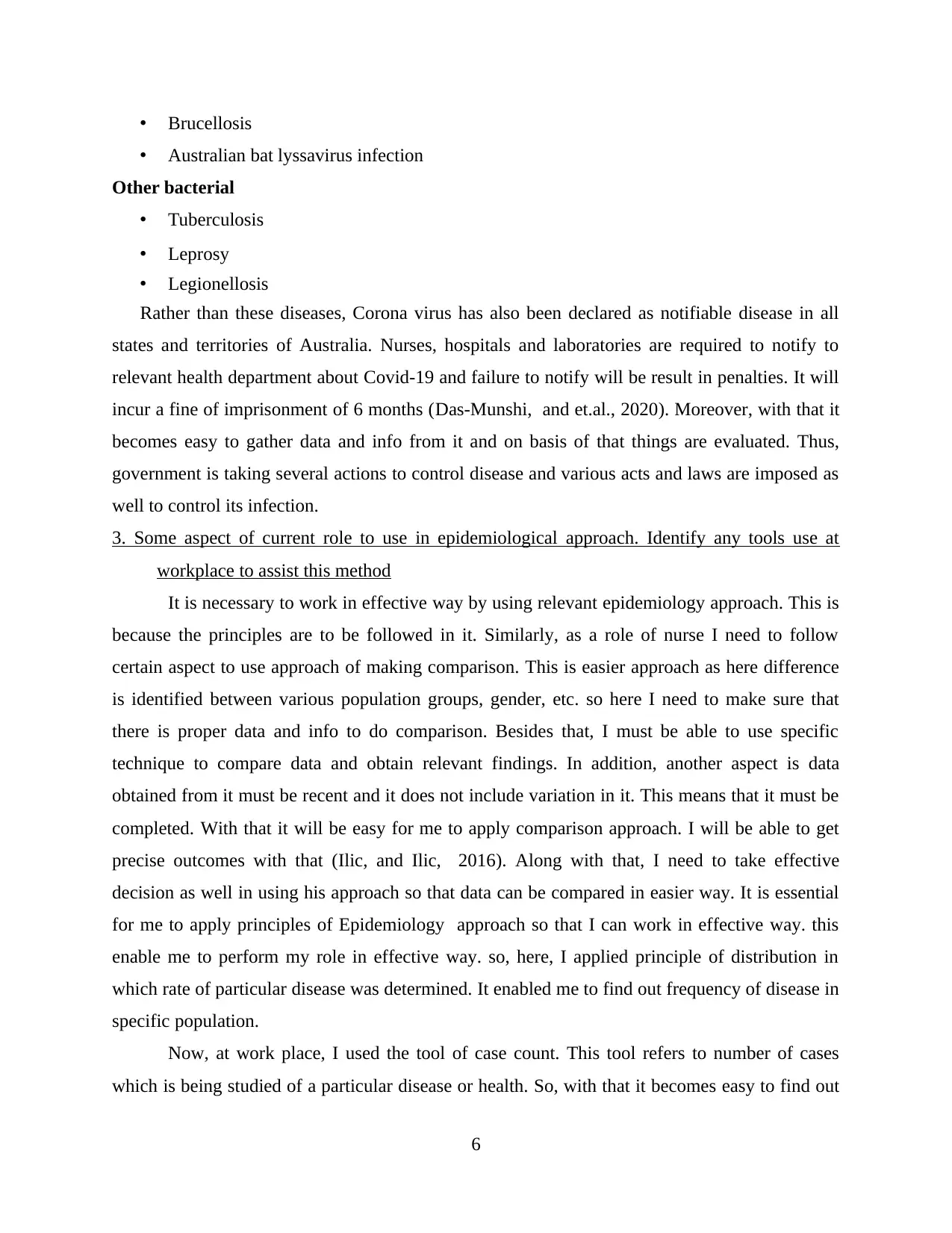
• Brucellosis
• Australian bat lyssavirus infection
Other bacterial
• Tuberculosis
• Leprosy
• Legionellosis
Rather than these diseases, Corona virus has also been declared as notifiable disease in all
states and territories of Australia. Nurses, hospitals and laboratories are required to notify to
relevant health department about Covid-19 and failure to notify will be result in penalties. It will
incur a fine of imprisonment of 6 months (Das-Munshi, and et.al., 2020). Moreover, with that it
becomes easy to gather data and info from it and on basis of that things are evaluated. Thus,
government is taking several actions to control disease and various acts and laws are imposed as
well to control its infection.
3. Some aspect of current role to use in epidemiological approach. Identify any tools use at
workplace to assist this method
It is necessary to work in effective way by using relevant epidemiology approach. This is
because the principles are to be followed in it. Similarly, as a role of nurse I need to follow
certain aspect to use approach of making comparison. This is easier approach as here difference
is identified between various population groups, gender, etc. so here I need to make sure that
there is proper data and info to do comparison. Besides that, I must be able to use specific
technique to compare data and obtain relevant findings. In addition, another aspect is data
obtained from it must be recent and it does not include variation in it. This means that it must be
completed. With that it will be easy for me to apply comparison approach. I will be able to get
precise outcomes with that (Ilic, and Ilic, 2016). Along with that, I need to take effective
decision as well in using his approach so that data can be compared in easier way. It is essential
for me to apply principles of Epidemiology approach so that I can work in effective way. this
enable me to perform my role in effective way. so, here, I applied principle of distribution in
which rate of particular disease was determined. It enabled me to find out frequency of disease in
specific population.
Now, at work place, I used the tool of case count. This tool refers to number of cases
which is being studied of a particular disease or health. So, with that it becomes easy to find out
6
• Australian bat lyssavirus infection
Other bacterial
• Tuberculosis
• Leprosy
• Legionellosis
Rather than these diseases, Corona virus has also been declared as notifiable disease in all
states and territories of Australia. Nurses, hospitals and laboratories are required to notify to
relevant health department about Covid-19 and failure to notify will be result in penalties. It will
incur a fine of imprisonment of 6 months (Das-Munshi, and et.al., 2020). Moreover, with that it
becomes easy to gather data and info from it and on basis of that things are evaluated. Thus,
government is taking several actions to control disease and various acts and laws are imposed as
well to control its infection.
3. Some aspect of current role to use in epidemiological approach. Identify any tools use at
workplace to assist this method
It is necessary to work in effective way by using relevant epidemiology approach. This is
because the principles are to be followed in it. Similarly, as a role of nurse I need to follow
certain aspect to use approach of making comparison. This is easier approach as here difference
is identified between various population groups, gender, etc. so here I need to make sure that
there is proper data and info to do comparison. Besides that, I must be able to use specific
technique to compare data and obtain relevant findings. In addition, another aspect is data
obtained from it must be recent and it does not include variation in it. This means that it must be
completed. With that it will be easy for me to apply comparison approach. I will be able to get
precise outcomes with that (Ilic, and Ilic, 2016). Along with that, I need to take effective
decision as well in using his approach so that data can be compared in easier way. It is essential
for me to apply principles of Epidemiology approach so that I can work in effective way. this
enable me to perform my role in effective way. so, here, I applied principle of distribution in
which rate of particular disease was determined. It enabled me to find out frequency of disease in
specific population.
Now, at work place, I used the tool of case count. This tool refers to number of cases
which is being studied of a particular disease or health. So, with that it becomes easy to find out
6
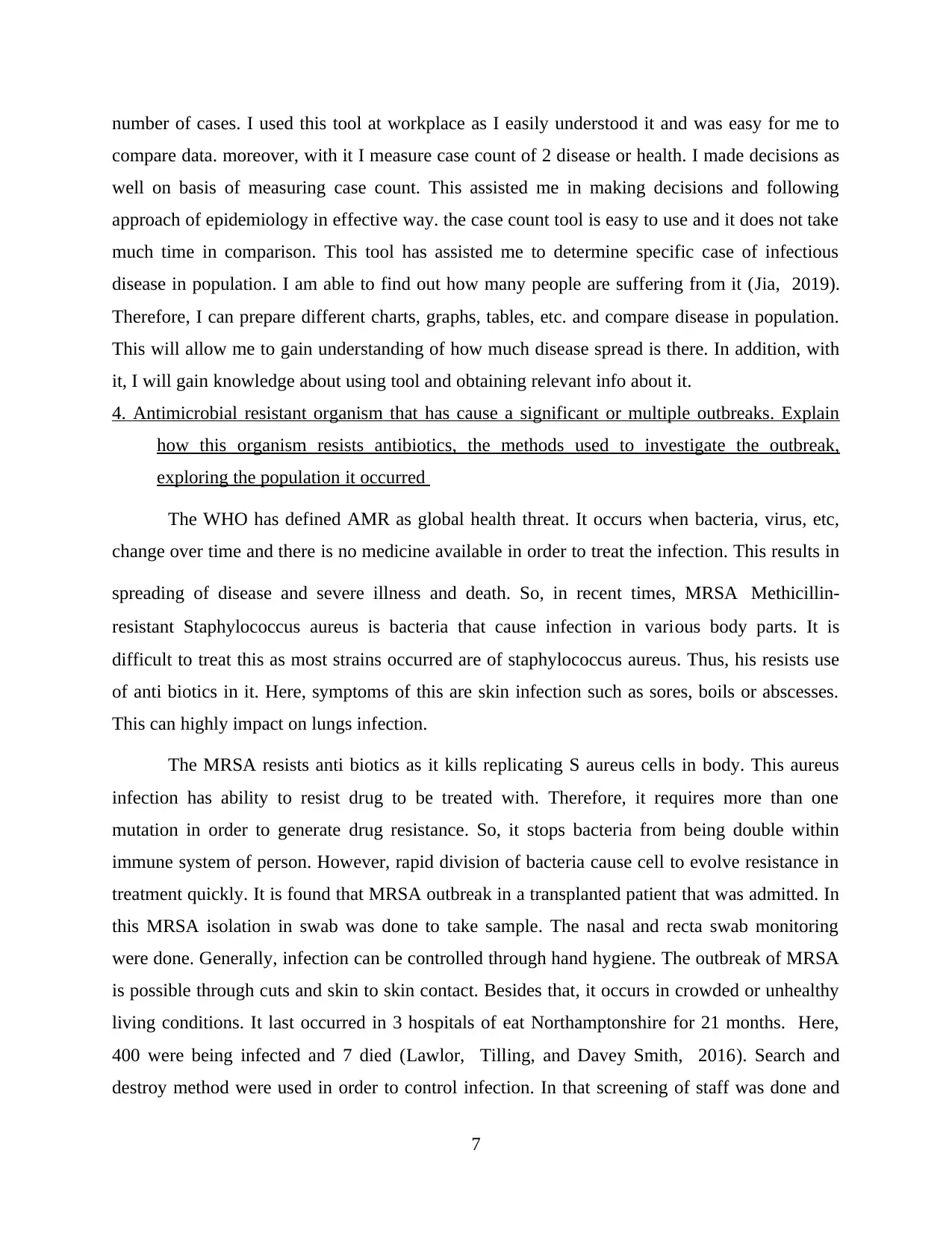
number of cases. I used this tool at workplace as I easily understood it and was easy for me to
compare data. moreover, with it I measure case count of 2 disease or health. I made decisions as
well on basis of measuring case count. This assisted me in making decisions and following
approach of epidemiology in effective way. the case count tool is easy to use and it does not take
much time in comparison. This tool has assisted me to determine specific case of infectious
disease in population. I am able to find out how many people are suffering from it (Jia, 2019).
Therefore, I can prepare different charts, graphs, tables, etc. and compare disease in population.
This will allow me to gain understanding of how much disease spread is there. In addition, with
it, I will gain knowledge about using tool and obtaining relevant info about it.
4. Antimicrobial resistant organism that has cause a significant or multiple outbreaks. Explain
how this organism resists antibiotics, the methods used to investigate the outbreak,
exploring the population it occurred
The WHO has defined AMR as global health threat. It occurs when bacteria, virus, etc,
change over time and there is no medicine available in order to treat the infection. This results in
spreading of disease and severe illness and death. So, in recent times, MRSA Methicillin-
resistant Staphylococcus aureus is bacteria that cause infection in various body parts. It is
difficult to treat this as most strains occurred are of staphylococcus aureus. Thus, his resists use
of anti biotics in it. Here, symptoms of this are skin infection such as sores, boils or abscesses.
This can highly impact on lungs infection.
The MRSA resists anti biotics as it kills replicating S aureus cells in body. This aureus
infection has ability to resist drug to be treated with. Therefore, it requires more than one
mutation in order to generate drug resistance. So, it stops bacteria from being double within
immune system of person. However, rapid division of bacteria cause cell to evolve resistance in
treatment quickly. It is found that MRSA outbreak in a transplanted patient that was admitted. In
this MRSA isolation in swab was done to take sample. The nasal and recta swab monitoring
were done. Generally, infection can be controlled through hand hygiene. The outbreak of MRSA
is possible through cuts and skin to skin contact. Besides that, it occurs in crowded or unhealthy
living conditions. It last occurred in 3 hospitals of eat Northamptonshire for 21 months. Here,
400 were being infected and 7 died (Lawlor, Tilling, and Davey Smith, 2016). Search and
destroy method were used in order to control infection. In that screening of staff was done and
7
compare data. moreover, with it I measure case count of 2 disease or health. I made decisions as
well on basis of measuring case count. This assisted me in making decisions and following
approach of epidemiology in effective way. the case count tool is easy to use and it does not take
much time in comparison. This tool has assisted me to determine specific case of infectious
disease in population. I am able to find out how many people are suffering from it (Jia, 2019).
Therefore, I can prepare different charts, graphs, tables, etc. and compare disease in population.
This will allow me to gain understanding of how much disease spread is there. In addition, with
it, I will gain knowledge about using tool and obtaining relevant info about it.
4. Antimicrobial resistant organism that has cause a significant or multiple outbreaks. Explain
how this organism resists antibiotics, the methods used to investigate the outbreak,
exploring the population it occurred
The WHO has defined AMR as global health threat. It occurs when bacteria, virus, etc,
change over time and there is no medicine available in order to treat the infection. This results in
spreading of disease and severe illness and death. So, in recent times, MRSA Methicillin-
resistant Staphylococcus aureus is bacteria that cause infection in various body parts. It is
difficult to treat this as most strains occurred are of staphylococcus aureus. Thus, his resists use
of anti biotics in it. Here, symptoms of this are skin infection such as sores, boils or abscesses.
This can highly impact on lungs infection.
The MRSA resists anti biotics as it kills replicating S aureus cells in body. This aureus
infection has ability to resist drug to be treated with. Therefore, it requires more than one
mutation in order to generate drug resistance. So, it stops bacteria from being double within
immune system of person. However, rapid division of bacteria cause cell to evolve resistance in
treatment quickly. It is found that MRSA outbreak in a transplanted patient that was admitted. In
this MRSA isolation in swab was done to take sample. The nasal and recta swab monitoring
were done. Generally, infection can be controlled through hand hygiene. The outbreak of MRSA
is possible through cuts and skin to skin contact. Besides that, it occurs in crowded or unhealthy
living conditions. It last occurred in 3 hospitals of eat Northamptonshire for 21 months. Here,
400 were being infected and 7 died (Lawlor, Tilling, and Davey Smith, 2016). Search and
destroy method were used in order to control infection. In that screening of staff was done and
7
Paraphrase This Document
Need a fresh take? Get an instant paraphrase of this document with our AI Paraphraser
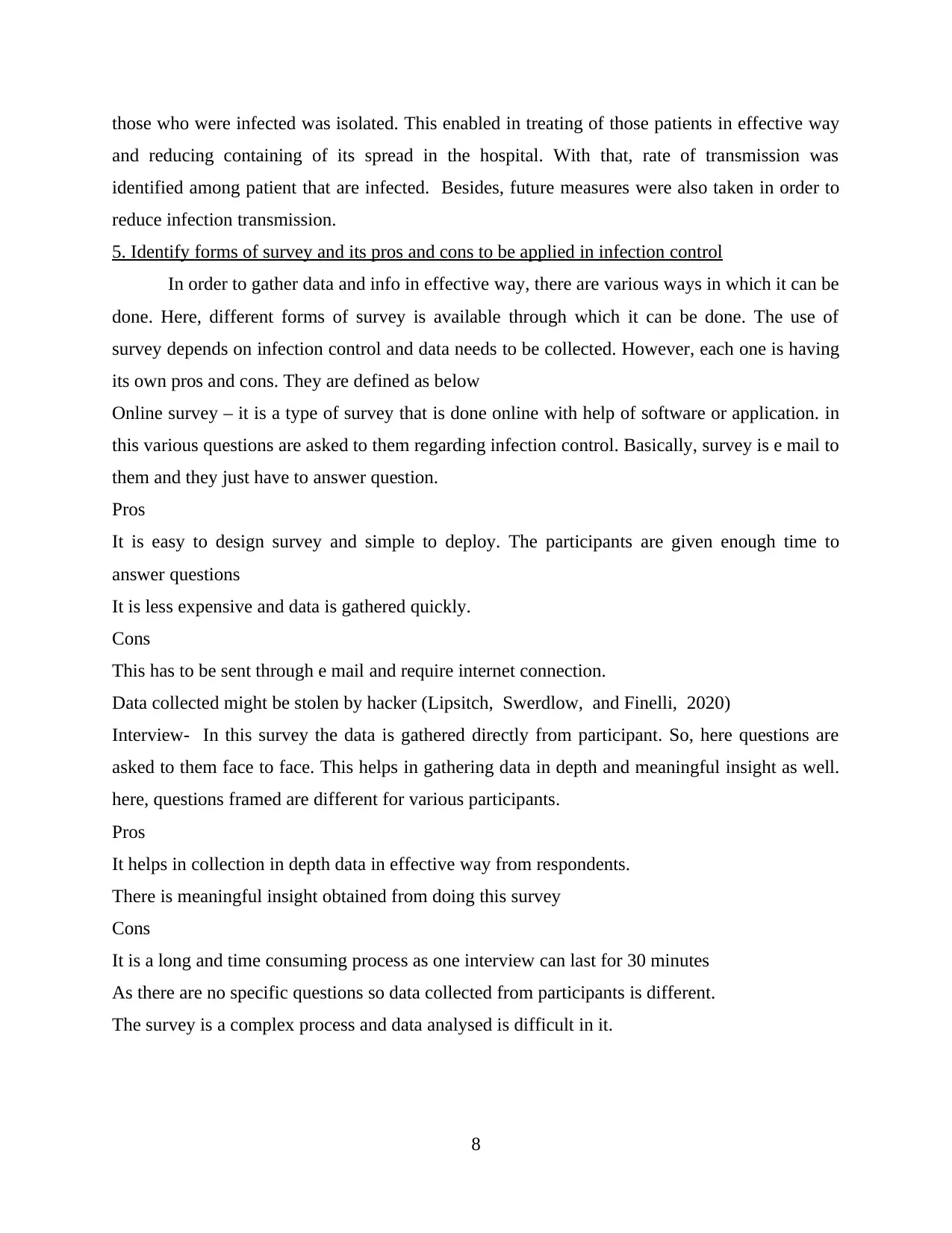
those who were infected was isolated. This enabled in treating of those patients in effective way
and reducing containing of its spread in the hospital. With that, rate of transmission was
identified among patient that are infected. Besides, future measures were also taken in order to
reduce infection transmission.
5. Identify forms of survey and its pros and cons to be applied in infection control
In order to gather data and info in effective way, there are various ways in which it can be
done. Here, different forms of survey is available through which it can be done. The use of
survey depends on infection control and data needs to be collected. However, each one is having
its own pros and cons. They are defined as below
Online survey – it is a type of survey that is done online with help of software or application. in
this various questions are asked to them regarding infection control. Basically, survey is e mail to
them and they just have to answer question.
Pros
It is easy to design survey and simple to deploy. The participants are given enough time to
answer questions
It is less expensive and data is gathered quickly.
Cons
This has to be sent through e mail and require internet connection.
Data collected might be stolen by hacker (Lipsitch, Swerdlow, and Finelli, 2020)
Interview- In this survey the data is gathered directly from participant. So, here questions are
asked to them face to face. This helps in gathering data in depth and meaningful insight as well.
here, questions framed are different for various participants.
Pros
It helps in collection in depth data in effective way from respondents.
There is meaningful insight obtained from doing this survey
Cons
It is a long and time consuming process as one interview can last for 30 minutes
As there are no specific questions so data collected from participants is different.
The survey is a complex process and data analysed is difficult in it.
8
and reducing containing of its spread in the hospital. With that, rate of transmission was
identified among patient that are infected. Besides, future measures were also taken in order to
reduce infection transmission.
5. Identify forms of survey and its pros and cons to be applied in infection control
In order to gather data and info in effective way, there are various ways in which it can be
done. Here, different forms of survey is available through which it can be done. The use of
survey depends on infection control and data needs to be collected. However, each one is having
its own pros and cons. They are defined as below
Online survey – it is a type of survey that is done online with help of software or application. in
this various questions are asked to them regarding infection control. Basically, survey is e mail to
them and they just have to answer question.
Pros
It is easy to design survey and simple to deploy. The participants are given enough time to
answer questions
It is less expensive and data is gathered quickly.
Cons
This has to be sent through e mail and require internet connection.
Data collected might be stolen by hacker (Lipsitch, Swerdlow, and Finelli, 2020)
Interview- In this survey the data is gathered directly from participant. So, here questions are
asked to them face to face. This helps in gathering data in depth and meaningful insight as well.
here, questions framed are different for various participants.
Pros
It helps in collection in depth data in effective way from respondents.
There is meaningful insight obtained from doing this survey
Cons
It is a long and time consuming process as one interview can last for 30 minutes
As there are no specific questions so data collected from participants is different.
The survey is a complex process and data analysed is difficult in it.
8
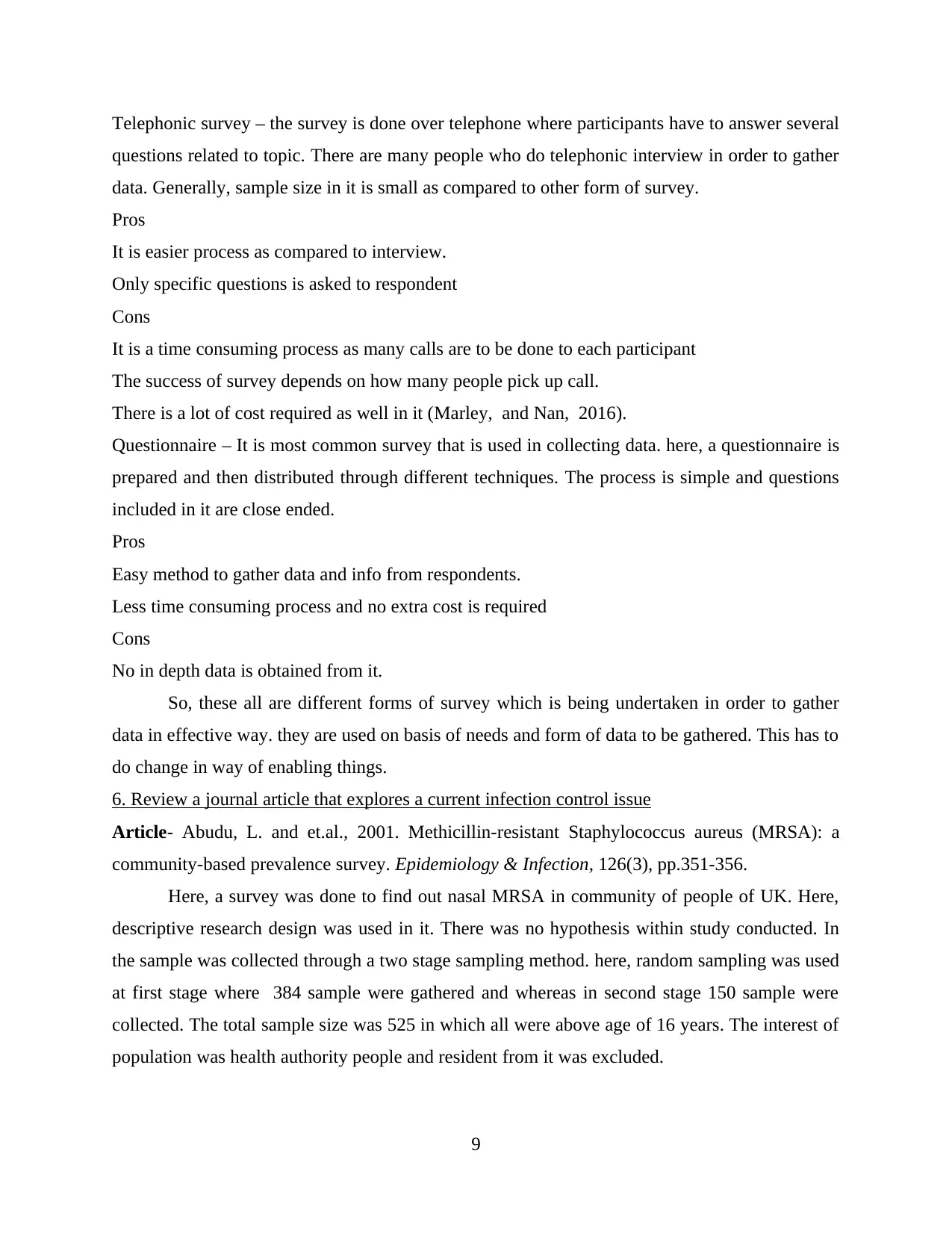
Telephonic survey – the survey is done over telephone where participants have to answer several
questions related to topic. There are many people who do telephonic interview in order to gather
data. Generally, sample size in it is small as compared to other form of survey.
Pros
It is easier process as compared to interview.
Only specific questions is asked to respondent
Cons
It is a time consuming process as many calls are to be done to each participant
The success of survey depends on how many people pick up call.
There is a lot of cost required as well in it (Marley, and Nan, 2016).
Questionnaire – It is most common survey that is used in collecting data. here, a questionnaire is
prepared and then distributed through different techniques. The process is simple and questions
included in it are close ended.
Pros
Easy method to gather data and info from respondents.
Less time consuming process and no extra cost is required
Cons
No in depth data is obtained from it.
So, these all are different forms of survey which is being undertaken in order to gather
data in effective way. they are used on basis of needs and form of data to be gathered. This has to
do change in way of enabling things.
6. Review a journal article that explores a current infection control issue
Article- Abudu, L. and et.al., 2001. Methicillin-resistant Staphylococcus aureus (MRSA): a
community-based prevalence survey. Epidemiology & Infection, 126(3), pp.351-356.
Here, a survey was done to find out nasal MRSA in community of people of UK. Here,
descriptive research design was used in it. There was no hypothesis within study conducted. In
the sample was collected through a two stage sampling method. here, random sampling was used
at first stage where 384 sample were gathered and whereas in second stage 150 sample were
collected. The total sample size was 525 in which all were above age of 16 years. The interest of
population was health authority people and resident from it was excluded.
9
questions related to topic. There are many people who do telephonic interview in order to gather
data. Generally, sample size in it is small as compared to other form of survey.
Pros
It is easier process as compared to interview.
Only specific questions is asked to respondent
Cons
It is a time consuming process as many calls are to be done to each participant
The success of survey depends on how many people pick up call.
There is a lot of cost required as well in it (Marley, and Nan, 2016).
Questionnaire – It is most common survey that is used in collecting data. here, a questionnaire is
prepared and then distributed through different techniques. The process is simple and questions
included in it are close ended.
Pros
Easy method to gather data and info from respondents.
Less time consuming process and no extra cost is required
Cons
No in depth data is obtained from it.
So, these all are different forms of survey which is being undertaken in order to gather
data in effective way. they are used on basis of needs and form of data to be gathered. This has to
do change in way of enabling things.
6. Review a journal article that explores a current infection control issue
Article- Abudu, L. and et.al., 2001. Methicillin-resistant Staphylococcus aureus (MRSA): a
community-based prevalence survey. Epidemiology & Infection, 126(3), pp.351-356.
Here, a survey was done to find out nasal MRSA in community of people of UK. Here,
descriptive research design was used in it. There was no hypothesis within study conducted. In
the sample was collected through a two stage sampling method. here, random sampling was used
at first stage where 384 sample were gathered and whereas in second stage 150 sample were
collected. The total sample size was 525 in which all were above age of 16 years. The interest of
population was health authority people and resident from it was excluded.
9
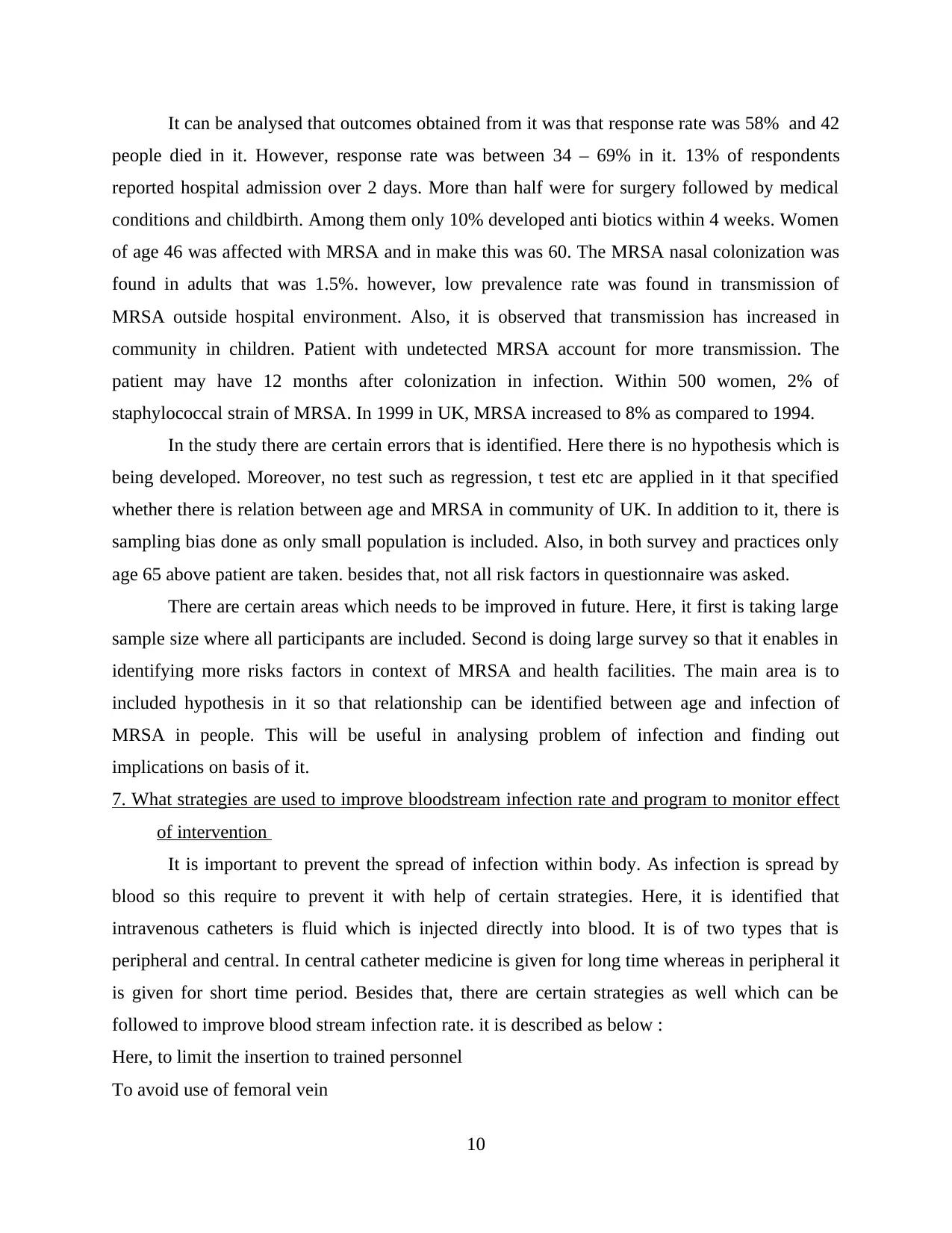
It can be analysed that outcomes obtained from it was that response rate was 58% and 42
people died in it. However, response rate was between 34 – 69% in it. 13% of respondents
reported hospital admission over 2 days. More than half were for surgery followed by medical
conditions and childbirth. Among them only 10% developed anti biotics within 4 weeks. Women
of age 46 was affected with MRSA and in make this was 60. The MRSA nasal colonization was
found in adults that was 1.5%. however, low prevalence rate was found in transmission of
MRSA outside hospital environment. Also, it is observed that transmission has increased in
community in children. Patient with undetected MRSA account for more transmission. The
patient may have 12 months after colonization in infection. Within 500 women, 2% of
staphylococcal strain of MRSA. In 1999 in UK, MRSA increased to 8% as compared to 1994.
In the study there are certain errors that is identified. Here there is no hypothesis which is
being developed. Moreover, no test such as regression, t test etc are applied in it that specified
whether there is relation between age and MRSA in community of UK. In addition to it, there is
sampling bias done as only small population is included. Also, in both survey and practices only
age 65 above patient are taken. besides that, not all risk factors in questionnaire was asked.
There are certain areas which needs to be improved in future. Here, it first is taking large
sample size where all participants are included. Second is doing large survey so that it enables in
identifying more risks factors in context of MRSA and health facilities. The main area is to
included hypothesis in it so that relationship can be identified between age and infection of
MRSA in people. This will be useful in analysing problem of infection and finding out
implications on basis of it.
7. What strategies are used to improve bloodstream infection rate and program to monitor effect
of intervention
It is important to prevent the spread of infection within body. As infection is spread by
blood so this require to prevent it with help of certain strategies. Here, it is identified that
intravenous catheters is fluid which is injected directly into blood. It is of two types that is
peripheral and central. In central catheter medicine is given for long time whereas in peripheral it
is given for short time period. Besides that, there are certain strategies as well which can be
followed to improve blood stream infection rate. it is described as below :
Here, to limit the insertion to trained personnel
To avoid use of femoral vein
10
people died in it. However, response rate was between 34 – 69% in it. 13% of respondents
reported hospital admission over 2 days. More than half were for surgery followed by medical
conditions and childbirth. Among them only 10% developed anti biotics within 4 weeks. Women
of age 46 was affected with MRSA and in make this was 60. The MRSA nasal colonization was
found in adults that was 1.5%. however, low prevalence rate was found in transmission of
MRSA outside hospital environment. Also, it is observed that transmission has increased in
community in children. Patient with undetected MRSA account for more transmission. The
patient may have 12 months after colonization in infection. Within 500 women, 2% of
staphylococcal strain of MRSA. In 1999 in UK, MRSA increased to 8% as compared to 1994.
In the study there are certain errors that is identified. Here there is no hypothesis which is
being developed. Moreover, no test such as regression, t test etc are applied in it that specified
whether there is relation between age and MRSA in community of UK. In addition to it, there is
sampling bias done as only small population is included. Also, in both survey and practices only
age 65 above patient are taken. besides that, not all risk factors in questionnaire was asked.
There are certain areas which needs to be improved in future. Here, it first is taking large
sample size where all participants are included. Second is doing large survey so that it enables in
identifying more risks factors in context of MRSA and health facilities. The main area is to
included hypothesis in it so that relationship can be identified between age and infection of
MRSA in people. This will be useful in analysing problem of infection and finding out
implications on basis of it.
7. What strategies are used to improve bloodstream infection rate and program to monitor effect
of intervention
It is important to prevent the spread of infection within body. As infection is spread by
blood so this require to prevent it with help of certain strategies. Here, it is identified that
intravenous catheters is fluid which is injected directly into blood. It is of two types that is
peripheral and central. In central catheter medicine is given for long time whereas in peripheral it
is given for short time period. Besides that, there are certain strategies as well which can be
followed to improve blood stream infection rate. it is described as below :
Here, to limit the insertion to trained personnel
To avoid use of femoral vein
10
Secure Best Marks with AI Grader
Need help grading? Try our AI Grader for instant feedback on your assignments.
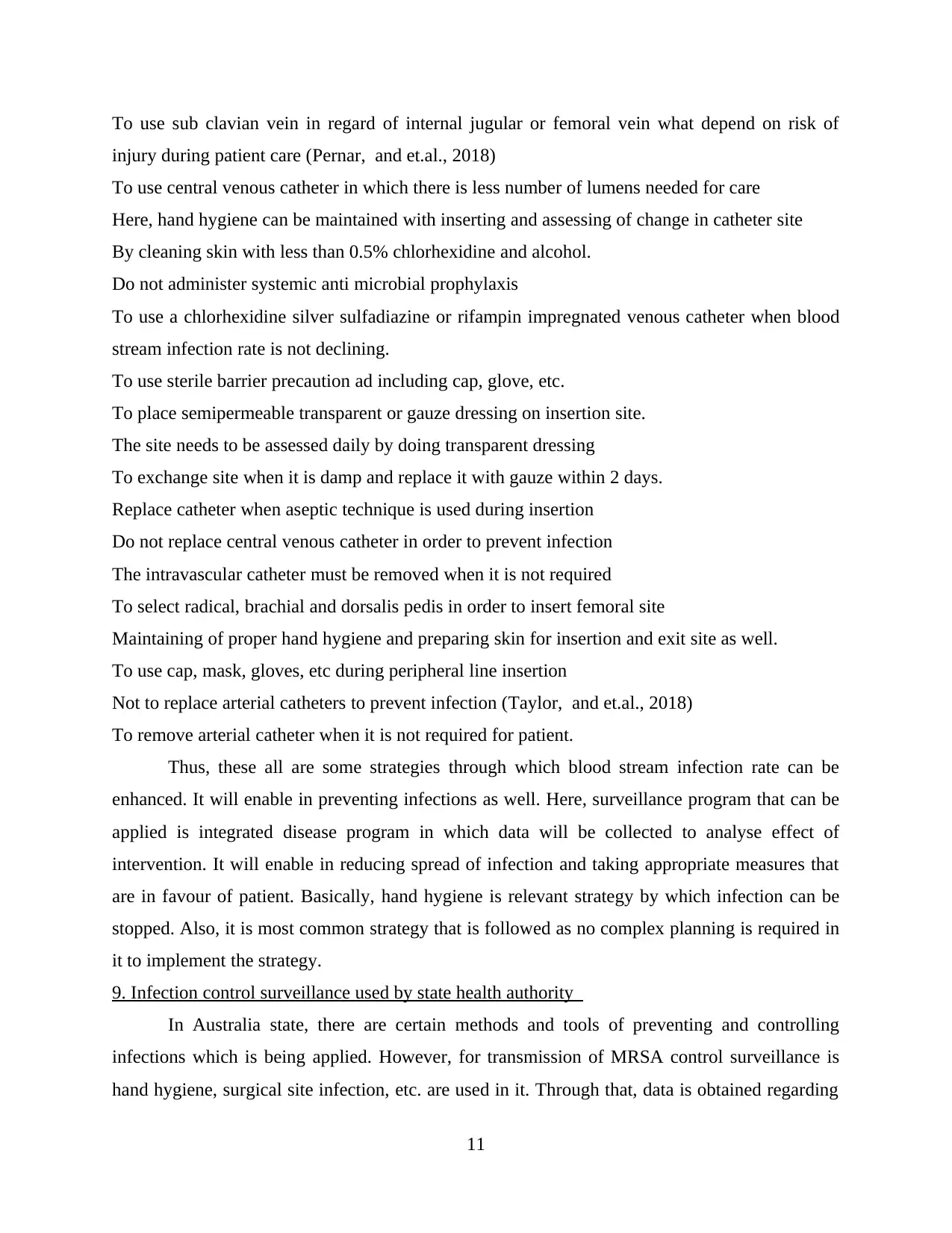
To use sub clavian vein in regard of internal jugular or femoral vein what depend on risk of
injury during patient care (Pernar, and et.al., 2018)
To use central venous catheter in which there is less number of lumens needed for care
Here, hand hygiene can be maintained with inserting and assessing of change in catheter site
By cleaning skin with less than 0.5% chlorhexidine and alcohol.
Do not administer systemic anti microbial prophylaxis
To use a chlorhexidine silver sulfadiazine or rifampin impregnated venous catheter when blood
stream infection rate is not declining.
To use sterile barrier precaution ad including cap, glove, etc.
To place semipermeable transparent or gauze dressing on insertion site.
The site needs to be assessed daily by doing transparent dressing
To exchange site when it is damp and replace it with gauze within 2 days.
Replace catheter when aseptic technique is used during insertion
Do not replace central venous catheter in order to prevent infection
The intravascular catheter must be removed when it is not required
To select radical, brachial and dorsalis pedis in order to insert femoral site
Maintaining of proper hand hygiene and preparing skin for insertion and exit site as well.
To use cap, mask, gloves, etc during peripheral line insertion
Not to replace arterial catheters to prevent infection (Taylor, and et.al., 2018)
To remove arterial catheter when it is not required for patient.
Thus, these all are some strategies through which blood stream infection rate can be
enhanced. It will enable in preventing infections as well. Here, surveillance program that can be
applied is integrated disease program in which data will be collected to analyse effect of
intervention. It will enable in reducing spread of infection and taking appropriate measures that
are in favour of patient. Basically, hand hygiene is relevant strategy by which infection can be
stopped. Also, it is most common strategy that is followed as no complex planning is required in
it to implement the strategy.
9. Infection control surveillance used by state health authority
In Australia state, there are certain methods and tools of preventing and controlling
infections which is being applied. However, for transmission of MRSA control surveillance is
hand hygiene, surgical site infection, etc. are used in it. Through that, data is obtained regarding
11
injury during patient care (Pernar, and et.al., 2018)
To use central venous catheter in which there is less number of lumens needed for care
Here, hand hygiene can be maintained with inserting and assessing of change in catheter site
By cleaning skin with less than 0.5% chlorhexidine and alcohol.
Do not administer systemic anti microbial prophylaxis
To use a chlorhexidine silver sulfadiazine or rifampin impregnated venous catheter when blood
stream infection rate is not declining.
To use sterile barrier precaution ad including cap, glove, etc.
To place semipermeable transparent or gauze dressing on insertion site.
The site needs to be assessed daily by doing transparent dressing
To exchange site when it is damp and replace it with gauze within 2 days.
Replace catheter when aseptic technique is used during insertion
Do not replace central venous catheter in order to prevent infection
The intravascular catheter must be removed when it is not required
To select radical, brachial and dorsalis pedis in order to insert femoral site
Maintaining of proper hand hygiene and preparing skin for insertion and exit site as well.
To use cap, mask, gloves, etc during peripheral line insertion
Not to replace arterial catheters to prevent infection (Taylor, and et.al., 2018)
To remove arterial catheter when it is not required for patient.
Thus, these all are some strategies through which blood stream infection rate can be
enhanced. It will enable in preventing infections as well. Here, surveillance program that can be
applied is integrated disease program in which data will be collected to analyse effect of
intervention. It will enable in reducing spread of infection and taking appropriate measures that
are in favour of patient. Basically, hand hygiene is relevant strategy by which infection can be
stopped. Also, it is most common strategy that is followed as no complex planning is required in
it to implement the strategy.
9. Infection control surveillance used by state health authority
In Australia state, there are certain methods and tools of preventing and controlling
infections which is being applied. However, for transmission of MRSA control surveillance is
hand hygiene, surgical site infection, etc. are used in it. Through that, data is obtained regarding
11
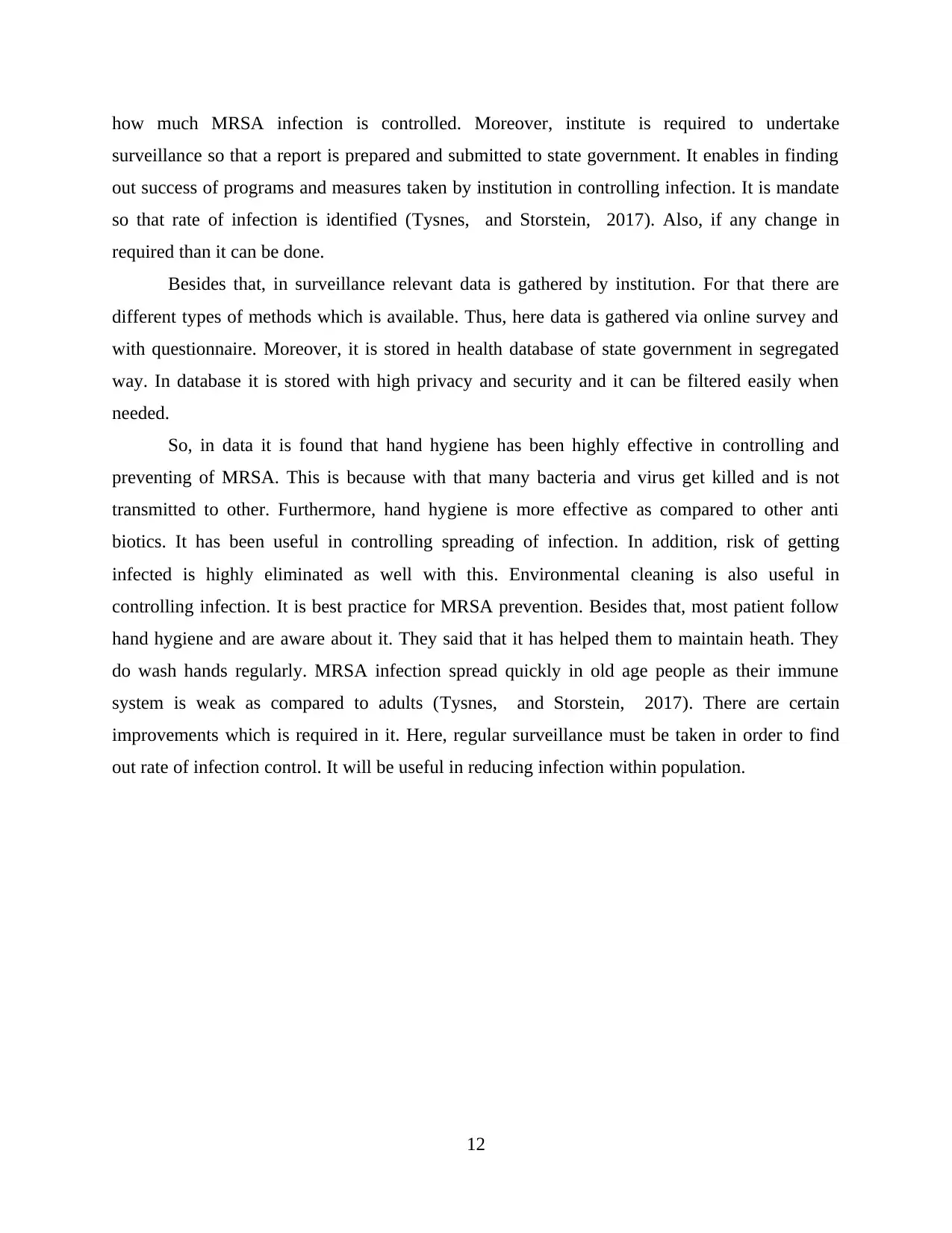
how much MRSA infection is controlled. Moreover, institute is required to undertake
surveillance so that a report is prepared and submitted to state government. It enables in finding
out success of programs and measures taken by institution in controlling infection. It is mandate
so that rate of infection is identified (Tysnes, and Storstein, 2017). Also, if any change in
required than it can be done.
Besides that, in surveillance relevant data is gathered by institution. For that there are
different types of methods which is available. Thus, here data is gathered via online survey and
with questionnaire. Moreover, it is stored in health database of state government in segregated
way. In database it is stored with high privacy and security and it can be filtered easily when
needed.
So, in data it is found that hand hygiene has been highly effective in controlling and
preventing of MRSA. This is because with that many bacteria and virus get killed and is not
transmitted to other. Furthermore, hand hygiene is more effective as compared to other anti
biotics. It has been useful in controlling spreading of infection. In addition, risk of getting
infected is highly eliminated as well with this. Environmental cleaning is also useful in
controlling infection. It is best practice for MRSA prevention. Besides that, most patient follow
hand hygiene and are aware about it. They said that it has helped them to maintain heath. They
do wash hands regularly. MRSA infection spread quickly in old age people as their immune
system is weak as compared to adults (Tysnes, and Storstein, 2017). There are certain
improvements which is required in it. Here, regular surveillance must be taken in order to find
out rate of infection control. It will be useful in reducing infection within population.
12
surveillance so that a report is prepared and submitted to state government. It enables in finding
out success of programs and measures taken by institution in controlling infection. It is mandate
so that rate of infection is identified (Tysnes, and Storstein, 2017). Also, if any change in
required than it can be done.
Besides that, in surveillance relevant data is gathered by institution. For that there are
different types of methods which is available. Thus, here data is gathered via online survey and
with questionnaire. Moreover, it is stored in health database of state government in segregated
way. In database it is stored with high privacy and security and it can be filtered easily when
needed.
So, in data it is found that hand hygiene has been highly effective in controlling and
preventing of MRSA. This is because with that many bacteria and virus get killed and is not
transmitted to other. Furthermore, hand hygiene is more effective as compared to other anti
biotics. It has been useful in controlling spreading of infection. In addition, risk of getting
infected is highly eliminated as well with this. Environmental cleaning is also useful in
controlling infection. It is best practice for MRSA prevention. Besides that, most patient follow
hand hygiene and are aware about it. They said that it has helped them to maintain heath. They
do wash hands regularly. MRSA infection spread quickly in old age people as their immune
system is weak as compared to adults (Tysnes, and Storstein, 2017). There are certain
improvements which is required in it. Here, regular surveillance must be taken in order to find
out rate of infection control. It will be useful in reducing infection within population.
12
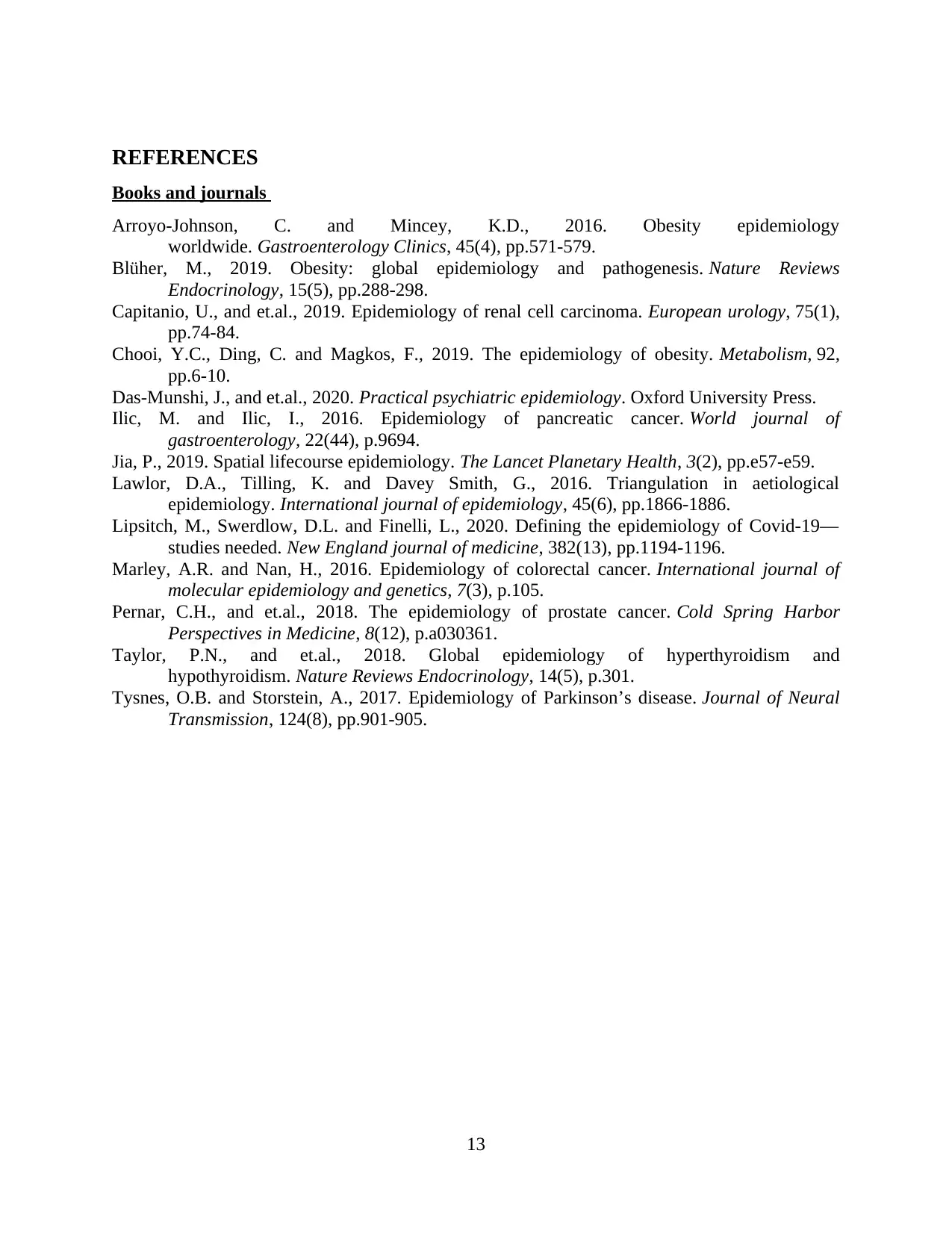
REFERENCES
Books and journals
Arroyo-Johnson, C. and Mincey, K.D., 2016. Obesity epidemiology
worldwide. Gastroenterology Clinics, 45(4), pp.571-579.
Blüher, M., 2019. Obesity: global epidemiology and pathogenesis. Nature Reviews
Endocrinology, 15(5), pp.288-298.
Capitanio, U., and et.al., 2019. Epidemiology of renal cell carcinoma. European urology, 75(1),
pp.74-84.
Chooi, Y.C., Ding, C. and Magkos, F., 2019. The epidemiology of obesity. Metabolism, 92,
pp.6-10.
Das-Munshi, J., and et.al., 2020. Practical psychiatric epidemiology. Oxford University Press.
Ilic, M. and Ilic, I., 2016. Epidemiology of pancreatic cancer. World journal of
gastroenterology, 22(44), p.9694.
Jia, P., 2019. Spatial lifecourse epidemiology. The Lancet Planetary Health, 3(2), pp.e57-e59.
Lawlor, D.A., Tilling, K. and Davey Smith, G., 2016. Triangulation in aetiological
epidemiology. International journal of epidemiology, 45(6), pp.1866-1886.
Lipsitch, M., Swerdlow, D.L. and Finelli, L., 2020. Defining the epidemiology of Covid-19—
studies needed. New England journal of medicine, 382(13), pp.1194-1196.
Marley, A.R. and Nan, H., 2016. Epidemiology of colorectal cancer. International journal of
molecular epidemiology and genetics, 7(3), p.105.
Pernar, C.H., and et.al., 2018. The epidemiology of prostate cancer. Cold Spring Harbor
Perspectives in Medicine, 8(12), p.a030361.
Taylor, P.N., and et.al., 2018. Global epidemiology of hyperthyroidism and
hypothyroidism. Nature Reviews Endocrinology, 14(5), p.301.
Tysnes, O.B. and Storstein, A., 2017. Epidemiology of Parkinson’s disease. Journal of Neural
Transmission, 124(8), pp.901-905.
13
Books and journals
Arroyo-Johnson, C. and Mincey, K.D., 2016. Obesity epidemiology
worldwide. Gastroenterology Clinics, 45(4), pp.571-579.
Blüher, M., 2019. Obesity: global epidemiology and pathogenesis. Nature Reviews
Endocrinology, 15(5), pp.288-298.
Capitanio, U., and et.al., 2019. Epidemiology of renal cell carcinoma. European urology, 75(1),
pp.74-84.
Chooi, Y.C., Ding, C. and Magkos, F., 2019. The epidemiology of obesity. Metabolism, 92,
pp.6-10.
Das-Munshi, J., and et.al., 2020. Practical psychiatric epidemiology. Oxford University Press.
Ilic, M. and Ilic, I., 2016. Epidemiology of pancreatic cancer. World journal of
gastroenterology, 22(44), p.9694.
Jia, P., 2019. Spatial lifecourse epidemiology. The Lancet Planetary Health, 3(2), pp.e57-e59.
Lawlor, D.A., Tilling, K. and Davey Smith, G., 2016. Triangulation in aetiological
epidemiology. International journal of epidemiology, 45(6), pp.1866-1886.
Lipsitch, M., Swerdlow, D.L. and Finelli, L., 2020. Defining the epidemiology of Covid-19—
studies needed. New England journal of medicine, 382(13), pp.1194-1196.
Marley, A.R. and Nan, H., 2016. Epidemiology of colorectal cancer. International journal of
molecular epidemiology and genetics, 7(3), p.105.
Pernar, C.H., and et.al., 2018. The epidemiology of prostate cancer. Cold Spring Harbor
Perspectives in Medicine, 8(12), p.a030361.
Taylor, P.N., and et.al., 2018. Global epidemiology of hyperthyroidism and
hypothyroidism. Nature Reviews Endocrinology, 14(5), p.301.
Tysnes, O.B. and Storstein, A., 2017. Epidemiology of Parkinson’s disease. Journal of Neural
Transmission, 124(8), pp.901-905.
13
1 out of 13
Related Documents
Your All-in-One AI-Powered Toolkit for Academic Success.
+13062052269
info@desklib.com
Available 24*7 on WhatsApp / Email
![[object Object]](/_next/static/media/star-bottom.7253800d.svg)
Unlock your academic potential
© 2024 | Zucol Services PVT LTD | All rights reserved.





